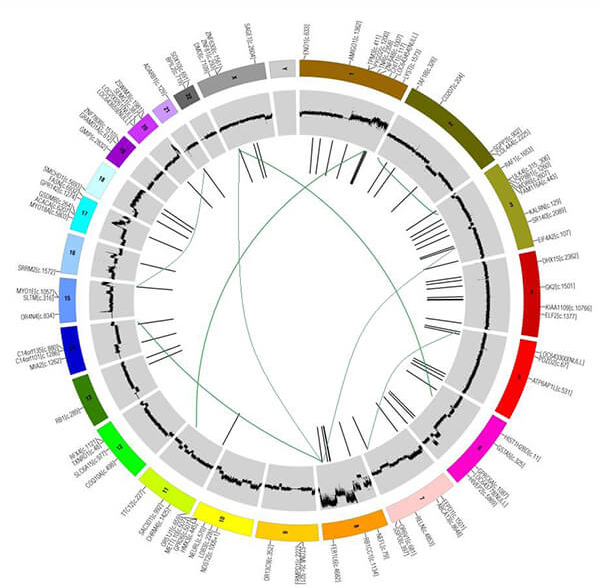
09/28/2016
The National Cancer Institute (NCI) announced a collaboration with the Multiple Myeloma Research Foundation (MMRF) to incorporate MMRF's wealth of genomic and clinical data on the disease into the NCI Genomic Data Commons (GDC), a publicly available database.
NCI collaborates with Multiple Myeloma Research Foundation
- Posted: September 28, 2016
Contact:
NCI Press Office
301-496-6641
The National Cancer Institute (NCI) announced a collaboration with the Multiple Myeloma Research Foundation (MMRF) to incorporate MMRF's wealth of genomic and clinical data about the disease into the NCI Genomic Data Commons (GDC), a publicly available database that promotes the sharing of genomic and clinical data among researchers and facilitates precision medicine in oncology. The MMRF, located in Norwalk, Connecticut, is the first nonprofit organization to donate information to the GDC, which will include data on more than 30,000 patients who have many other types of cancers by the end of the year. NCI is part of the National Institutes of Health.
Multiple myeloma is the second most common blood cancer, but large amounts of genomic data about this disease and other cancers have not been readily accessible to the research community. At a meeting in Boston today, theHealth Care Forum: War on Cancer hosted by The Economist, leaders in the healthcare field discussed the benefits of this new partnership.
“Data sharing is essential to advancing cancer research, and I cannot overstate the value of the data that MMRF is providing — not only genomic data but also full clinical data as well,” said Doug Lowy, M.D., NCI acting director. “Combining genomic and clinical information will create an invaluable resource for all researchers worldwide studying this disease who are working toward new, more effective treatments.”
“The MMRF is a research and advocacy organization conducting clinical studies that incorporate whole-genome, whole-exome, and RNA sequencing into their study analyses," said Louis Staudt, M.D., Ph.D., director of NCI's Center for Cancer Genomics. “The GDC gains power with each new submission, and the contribution of MMRF data will enable the discovery of potentially actionable and life-changing insights into multiple myeloma and its response to therapy that could be used by cancer researchers, doctors, and patients.”
Launched earlier this year, the GDC allows researchers to submit genetic and clinical data, such as cancer imaging and histological data, and integrate these data with information on the molecular profiles of tumors as well as treatment responses. Importantly, all patient information in the GDC has been de-identified, meaning that personal information, such as addresses, Social Security numbers, and other possible identifiers, are not present — only crucial genetic data and key demographic information are available.
An important contribution to the GDC will be information from MMRF’s newest genomic study, Relating Clinical Outcomes in MM to Personal Assessment of Genetic Profile (CoMMpass, NCT01454297). The trial has enrolled more than 1,150 patients to date and is currently the largest genomic and clinical study of this disease. African Americans represent about 18 percent of the patients enrolled CoMMpass, based on an interim analysis. The participation of African Americans in this study is significant given that multiple myeloma occurs about twice as often in African Americans than in whites.
Over the next eight years or longer, patients in CoMMpass will get a repeat biopsy and a new genomic analysis at each six-month checkup and/or at disease progression. Tumorsamples are being collected and analyzed when possible at the time of any relapse. The genomic data from these analyses will be immediately deposited in the GDC, with an anticipated sample size of near 1,000 cases by the spring of 2017. New data will be deposited every six months at a minimum.
The MMRF will also share data from the 204-patient Towards a Genomic Understanding of Myeloma study, also known as the MMRF Multiple Myeloma Genomics Initiative. Through this initiative, whole genome sequencing of the myeloma genome was completed for the first time.
"GDC’s visualization tools and browsing capabilities will make the MMRF myeloma data more accessible and could help jumpstart research into this cancer," noted Staudt.
The GDC is a core component of the Cancer Moonshot and the President’s Precision Medicine Initiative®, and it benefits from $70 million allocated to NCI to lead efforts in cancer genomics as part of the initiative.
About the National Cancer Institute (NCI): NCI leads the National Cancer Program and the NIH’s efforts to dramatically reduce the prevalence of cancer and improve the lives of cancer patients and their families, through research into prevention and cancer biology, the development of new interventions, and the training and mentoring of new researchers. For more information about cancer, please visit the NCI website at cancer.gov or call NCI's Cancer Information Service at 1-800-4-CANCER.
About the National Institutes of Health (NIH): NIH, the nation's medical research agency, includes 27 Institutes and Centers and is a component of the U.S. Department of Health and Human Services. NIH is the primary federal agency conducting and supporting basic, clinical, and translational medical research, and is investigating the causes, treatments, and cures for both common and rare diseases. For more information about NIH and its programs, visit nih.gov.























.png)












No hay comentarios:
Publicar un comentario